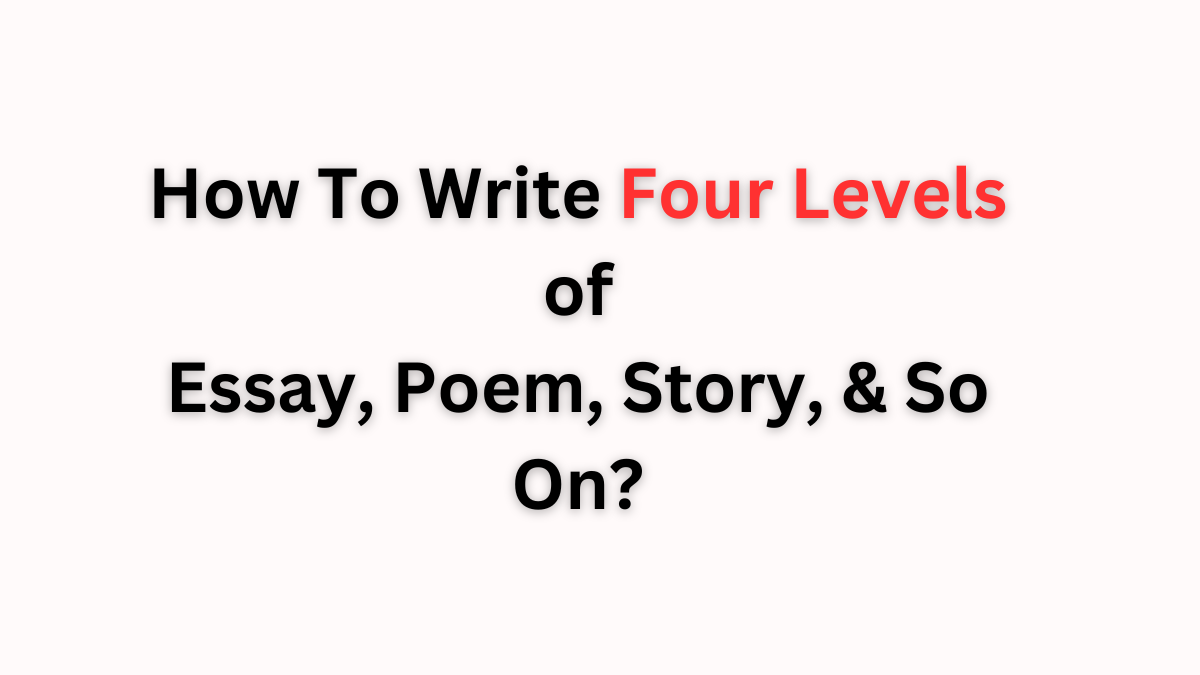Four Levels Writing
How to write four levels? Four levels of study as well as four-level writing for any essay, poem, story, drama, etc. is a compulsory task for the students especially those who are new to the bachelor course.
Moreover, especially for those students who have chosen management fields such as BBA, BBS, BHM, BA, and others.
You may have been confused about how to apply four levels of text if you are in your bachelor’s first year, maybe.
Here I have outlined some techniques for four levels of writing to make you understand its different parts and prepare to apply these to different essays, stories, poems, and dramas.

The parts of four levels of writing include four – literal comprehension, interpretation, critical thinking, and assimilation. This means that whenever you write four levels of any story or poem you have to write based on these four parts.
Now let’s understand what are they and how can they be applied to different stories and poems correctly.
Literal Comprehension
Literal comprehension is the first step to writing the four levels of any text. Under this step, you have to write the main event of the related text.
Here, in literal comprehension, you just have to write about what happened in the text (story or drama). In addition, the following are some of the topics you should include in your four levels of literal comprehension part.
- Just you have to understand what event happens and write them.
- Briefly write the event of the text.
- Well, understanding of the text.
- Ability to restate the proper arguments.
- Write only the context of the related text.
- Write what is given in the poem, story, and essay.
- Who is the writer or about the writer?
- When/where is the story taking place?
Interpretation
Interpretation is the second step of writing four levels of any text. In the interpretation part, you have to write the central theme of the text.
You have to understand the main theme of the text and write down them. Write only the main gist of the text. Moreover, you should follow these.
- Write what you have understood from the related text.
- Express the central theme and idea of the text.
- Text & understanding must be mixed.
- Don’t question the author.
- Just follow your mind with the relation to the given text, and lesson.
- A Question can some points be extended to circumstances beyond those directly touched upon by the author?
Critical Thinking/Analysis
As we discussed the interpretation part for the four levels. Likewise, critical thinking or analysis is the third step to writing the four levels of any text.
This step is too simple to write. Under this part, you can question the writer or the text’s statements. Similarly, make positive and negative comments about the events of the text.
Here, you can easily positively comment on the events of the text as well as raise questions about the text’s events. Maybe you can also read below:
- Use of reason to see the text.
- Showing positive & negative aspects.
- The factual & objective interpretation of the text.
- Question to the author, writer, character, situation, events of the text, etc.
- Use of the brain to analyze the text rather than explain already been given.
- Being curious why this & why not other.
Raise questions like,
- Where did the author go wrong?
- Which statements can’t I accept?
- Why can I accept them?
- Why I can not accept the text’s events? etc.
Assimilation
After literal comprehension, interpretation, and critical thinking, assimilation is the last part of the four levels of writing.
To write this part we have to thoroughly understand the text. Hence in this step, you have to write those things that you have understood from the text.
You can write the message you get from the text as well as you can also recommend others to follow such messages.
Likewise, you can also make a story that relates to your life as well as text. To clarify this part you can also see these ways:
- Being independent to see a text in your way.
- Mention how this text is similar to your life events.
- Can I tie this text to something that I have already known?
- Does it enhance my appreciation for good things?
- Does it suggest some connections that I have never perceived before?
- Write any story or events that relate to the text.
Hence in conclusion…
In part of literal comprehension, you have to write the main event of the related text. In part of interpretation, just write what the main point the text tries to say. In part of critical thinking, you will be free to comment on the text in either a negative or positive way. And, at last in part of assimilation, you have to write your understanding of the text and you can also make a story of your life events that relate to the text.
Examples of Four Levels of Writing
Following are some examples of four levels of texts you can get ideas from.
Good Luck. Hope you understand how to write four levels of any text.
